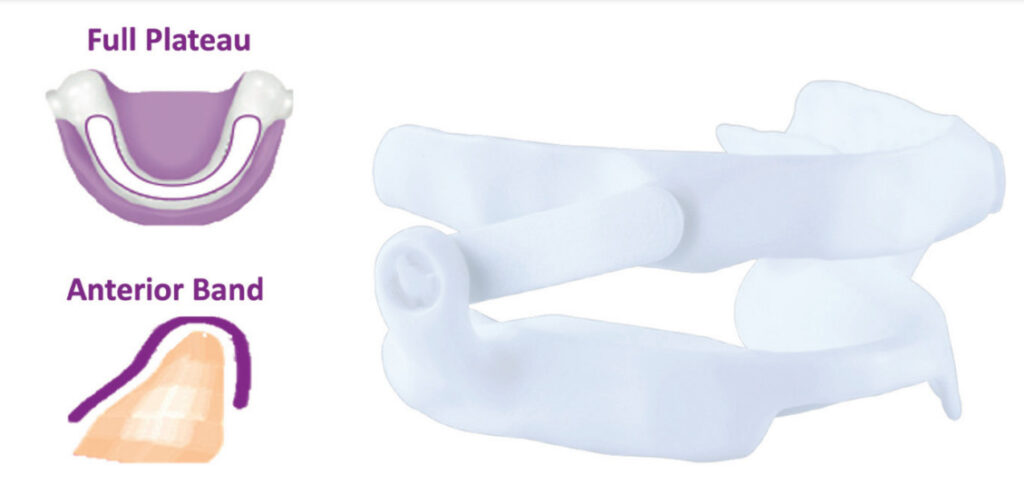Dr. John Viviano sheds light on the “if” and “why” of tooth movement from wearing an OAT.
 by John Viviano, DDS, D.ABDSM
by John Viviano, DDS, D.ABDSM
I am not aware of anyone that has died from a bite change. I’ve studied the literature. I’ve asked my colleagues. Nothing! Many of you have heard that before, but this debate still rages in the minds of some referrers, a few patients, and many of our dentist colleagues. The potential for bite changes is oft cited as rationale to preclude someone in need from receiving Oral Appliance Therapy (OAT).
When it comes to OAT, there should be no question about if teeth will move. It’s as if any recollection of ORTHO 101 has been erased from our minds. Let’s have a quick refresher. We learned many surprising things in first year ortho class:
- Teeth move
- Teeth can be moved by placing a subtle force on them
- Any level of force will eventually move teeth
There, you have just reviewed the basics of orthodontic therapy, and now you can schedule your first clear aligner case!
There are manifold examples in general dentistry of subtle forces leading to tooth movement, such as those associated with tongue thrusting, thumb sucking, and mouth breathing. All these lead to not only tooth movement but also dental arch malformation. We all know this. However, we expect to use OAT and not experience any tooth movement, with some oral appliance manufacturers even claiming that their appliance design does not move teeth at all! How can I put this politely, “BALDERDASH!”
We can’t cheat physics. These dental changes are all explained by Newton’s Third Law of Motion which states, “For every action, there is an equal and opposite reaction.” If you sit in a chair, your body exerts a downward force on the chair and the chair exerts an upward force on your body. So, two forces result from this interaction: a force on the chair (the action) and a force on your body (the reaction). The “force size” equals the size of the reaction force, and the direction of the reaction force is opposite to the direction of the applied force. In summary, forces always come in equal and opposite, “action-reaction” force pairs. Yet, some would have us believe that the Laws of Physics simply do not apply in the oral cavity by making claims that their oral appliances do not move teeth.
OAT enforces a particular mandibular posture by engaging the upper and lower jaw by the teeth and maintaining a specific position. In accordance with the discussion above, forces such as those applied by gravity (which vary depending on sleep position) and bruxism (which vary depending on intensity and frequency) will result in equal and opposite “action-reaction” force pairs, that will in accordance with ORTHO 101 impact on tooth movement. Rather than claiming that a particular appliance design does not move teeth, perhaps a more meaningful approach could be, “How can we minimize the consequences of “action-reaction” force pairs associated with sleep apnea oral appliance wear?”
Now we ask the question, “Will the consequences of these forces be the same on everyone’s dentition?” We can posit that the consequences will not be the same. Appliance design is a major contributing factor; does the appliance push or pull the lower jaw forward, are forces oblique or horizontal to the occlusal plane and does the appliance allow for movement or does it fix the jaws in a specific position? Another major contributing factor is the level of force, which can be influenced by sleep position and the level of bruxism. Finally, there are patient-specific contributing factors to consider; periodontal status (bone levels), edentulous areas, degree of mandibular advancement, and hours of appliance wear.
When it comes to OAT, there should be no question about if teeth will move.
The literature robustly supports the notion that OAT creates bite changes.1 However, as discussed above, tooth movement is influenced by a number of factors aside from the actual oral appliance, some of which are difficult to control. Consequently, studies in this area must be scrutinized carefully, and without a body of evidence to support a particular finding, generalizations regarding tooth movement and prevention of tooth movement may be difficult to substantiate.
Norrhem et al.2 conducted a tooth movement study of bite changes associated with a rigid Dorsal-style acrylic appliance that contacted all of the mandibular teeth, to those associated with a flexible nylon appliance that limited mandibular tooth contact from the cuspids distally, with no anterior tooth contact. Significant anterior crowding was documented with the appliance that did not contact the anterior teeth. The authors found that the posterior teeth, which were engaged by the appliance moved mesially “en bloc”, while the anterior teeth which were not engaged by the appliance, and thus not subjected to forces, simply crowded. Some have chosen to refer to this as evidence that an appliance that engages the entire dentition does not move teeth. Is this really the case? Or is the movement more uniform and less obvious? Or will it simply take longer for the movement to become statistically significant? Considering Newton’s Third Law, actually setting a standard that defies the Laws of Physics is not a responsible use of literature findings; potentially setting both patients and referrers up for disappointment.
The nylon appliance studied by Norrhem et al. was the Narval appliance (Resmed, San Diego, CA). With a similar design to the aforementioned Narval, the D-SAD (Panthera, Quebec City, Canada) has been modified to incorporate what we’ve learned from the research (Figure 1). Panthera now recommends that the lower arch be a full plateau and that the anterior band be placed on the lingual and wrap over the incisal, all making the lower arch of the D-SAD more rigid. In addition, Panthera now also makes the anterior band thicker and places it a mere 0.2 mm away from the dentition, further adding to rigidity and minimizing the likelihood of anterior crowding. These design modifications are an example of responsible use of literature findings; improvement of appliance design in an effort to reduce tooth movement associated with OAT.

Another study evaluating tooth movement further demonstrates how bite changes are appliance-design specific. This study documented bite changes associated with a Herbst-like appliance whose design uses downward and forward, oblique compression forces (Figure 2). These investigators found an intrusive with distal inclination tooth movement of the maxillary posterior teeth and an intrusive with anterior inclination tooth movement of the mandibular anterior teeth.3 How do these findings differ from those expected based on basic orthodontic principles?

It appears that tooth movement varies depending on appliance design. With more strictly controlled studies, perhaps we will be better able to determine which designs minimize this eventuality. However, no appliance can cheat physics. When it comes to claims of preventing tooth movement in the absence of a body of evidence, “caveat emptor.” I advise my patients that their teeth naturally move throughout their lifetime and that the appliance will likely contribute to this tooth movement in an appliance specific manner. Not only are these expectations less likely to result in disappointment, advising a patient that a particular appliance will prevent bite changes all together simply defies both physics and logic.
…the literature documents tooth movement from CPAP wear as well.
We have now shed some light on the “IF” and “WHY” OAT causes tooth movement. However, there is another elephant in the room – “jaw posture.” Our mandible is suspended in a muscular sling from the maxillae, and daytime jaw posture can sometimes change over time as influenced by wearing a sleep apnea oral appliance. This change can be influenced by factors such as the degree of mandibular advancement and the effort a patient is willing to put into reclaiming their habitual bite every morning. In consideration of this phenomenon, the American Academy of Dental Sleep Medicine (AADSM) has published an alternate definition of habitual occlusion for us to consider. “The position of closure between the dental arches in which the patient feels the teeth fit most comfortably with minimal feeling of stress in the muscles and joints.” This further complicates the monitoring of bite changes caused by a specific appliance, and I would suggest, even speaks to just how insignificant these bite changes are. Finally, for those wondering if CPAP would be a better option to minimize these bite changes, the literature documents tooth movement from CPAP wear as well.4,5
OSA is a life-threatening disorder that reduces both quality and longevity of life. Studies show that most patients are not even aware of their oral appliance-related bite change until it is pointed out to them by a dental professional.1,6 According to Gordon Christensen, “Occlusion is a constantly changing, dynamic state that is almost never the same from day to day.”7 As clinicians, we really need to focus on our patients’ overall health and keep our unhealthy obsession with occlusion in check. Remember, no one has ever died of a bite change!
Dr. Viviano’s CE, “Oral Appliance Therapy; The definition of Effectiveness,” discusses the effectiveness of OAT and PAP. Read the article and take the quiz to obtain 2 CE credits! https://dentalsleeppractice.com/ce-articles/oral-appliance-therapy-the-definition-of-effectiveness/
- Sheats et al., Management of side effects of oral appliance therapy for sleep-disordered breathing. Journal of Dental Sleep Medicine. 2017;4(4):111–125
- Norrhem et al. Changes in lower incisor irregularity during treatment with oral sleep apnea appliances. Sleep Breath; Published On-line JAN 23 2017 DOI 10.1007/s11325-016-1456-3
- Cohen-Levy, J., Pételle, B., Pinguet, J. et al. Forces created by mandibular advancement devices in OSAS patients. Sleep Breath17, 781–789 (2013). https://doi.org/10.1007/s11325-012-0765-4
- Pliska BT, Almeida FR. Tooth movement associated with CPAP therapy. J Clin Sleep Med. 2018;14(4):701–702.
- Tsuda et al. Craniofacial changes after 2 years of nasal continuous positive airway pressure use in patients with obstructive sleep apnea. Chest 2010 Oct;138(4):870-4
- Tsuda et al. Practical considerations for effective oral appliance use in the treatment of obstructive sleep apnea: a clinical review. Sleep Science and Practice (2017) 1:12
- Christensen G. What causes changes in occlusion? Dental Economics July 15, 2013


 Dr. Viviano obtained his credentials from the University of Toronto in 1983. His clinic is limited to managing sleep-disordered breathing and sleep-related bruxism. He is a Credentialed Diplomate of the American Board of Dental Sleep Medicine and has lectured internationally, conducted original research, and authored original articles on the management of sleep-disordered breathing. His clinic is the first Canadian facility accredited by the American Academy of Dental Sleep Medicine and he is Clinical Director of the Sleep Disorders Dentistry Research and Learning Centre. Dr. Viviano also hosts the SleepDisordersDentistry LinkedIn Discussion Group and conducts dental sleep medicine CE programs for various levels of experience, including a 4-day mini residency. Dr. Viviano’s Class and Cloud Based CE programs can be found on SDDacademy.com, and he can be reached at (905) 212-7732 or via the website
Dr. Viviano obtained his credentials from the University of Toronto in 1983. His clinic is limited to managing sleep-disordered breathing and sleep-related bruxism. He is a Credentialed Diplomate of the American Board of Dental Sleep Medicine and has lectured internationally, conducted original research, and authored original articles on the management of sleep-disordered breathing. His clinic is the first Canadian facility accredited by the American Academy of Dental Sleep Medicine and he is Clinical Director of the Sleep Disorders Dentistry Research and Learning Centre. Dr. Viviano also hosts the SleepDisordersDentistry LinkedIn Discussion Group and conducts dental sleep medicine CE programs for various levels of experience, including a 4-day mini residency. Dr. Viviano’s Class and Cloud Based CE programs can be found on SDDacademy.com, and he can be reached at (905) 212-7732 or via the website